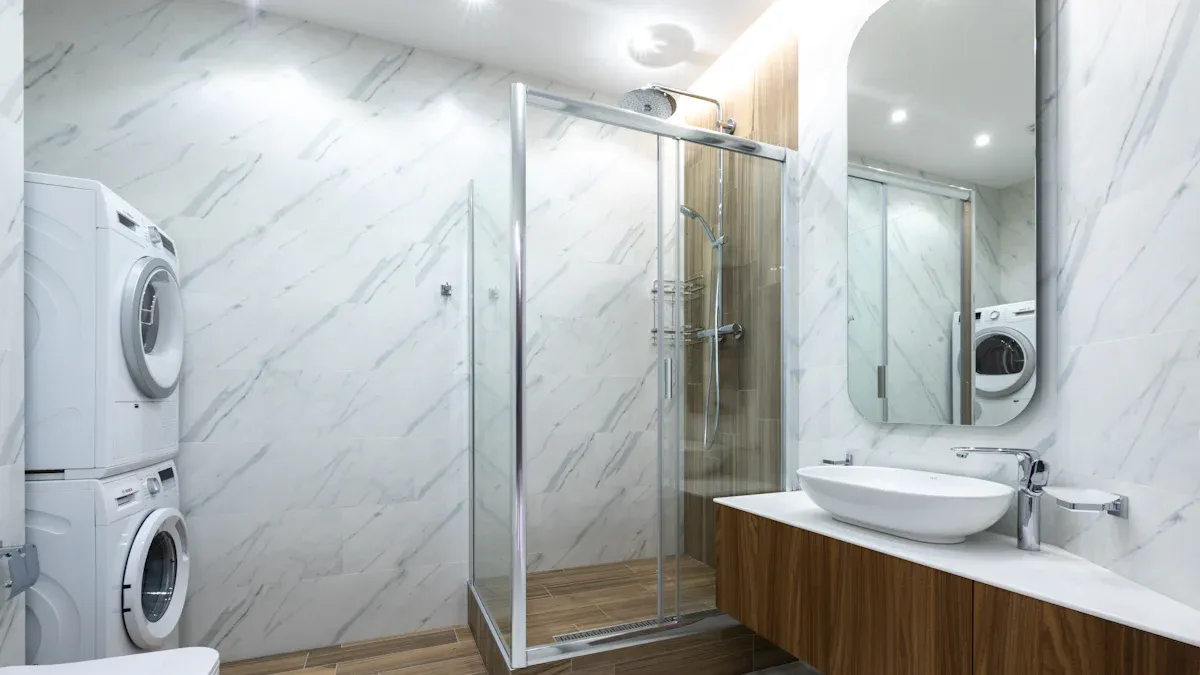
16 Oct A Complete Guide to Mold Resistant Wall Panels for Wet Areas
Table of Contents
You can keep your bathroom, kitchen, laundry room, or shower safe from mold by picking the right mold resistant wall panel. Waterproof wall panels block water and help stop mold and mildew. Many people like panels made from PVC, acrylic, solid surface, or laminated MDF. These choices do not scratch easily, last a long time, and look nice. This guide helps you choose the best panels for wet places in your home.
Key Takeaways
Pick mold resistant wall panels made from PVC, SPC, or MgO. These materials help stop moisture and mold. – Find panels with antimicrobial features. This helps keep your bathroom and kitchen clean and healthy. – Clean your wall panels often with mild soap. This stops mold from growing and keeps them looking nice. – Check your panels at least once a year. This helps you find problems early and makes them last longer. – Choose panels that match your style and budget. Make sure they are strong and easy to take care of.
Best Mold Resistant Wall Panel Options
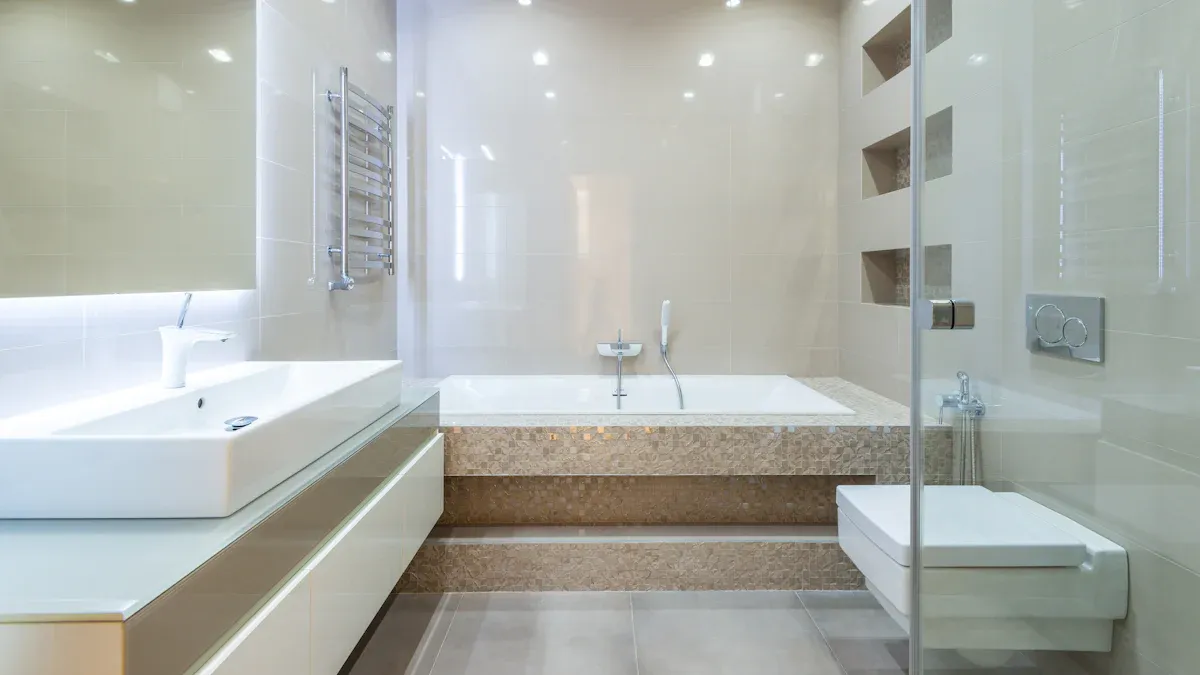
Top Materials
If you want mold resistant wall panels for wet places, you have many good choices. Each kind of panel helps your shower, bathroom, kitchen, or laundry room in different ways. You should pick materials that keep water out, stop mildew, and last for years. Here are the main waterproof wall panels you can use:
Material | Main Features | Fireproof | Best Use Areas |
|---|---|---|---|
PVC Panels | Lightweight, easy to clean, antimicrobial | No | Shower, bathroom |
SPC Panels | Stone-plastic core, rigid, waterproof | Yes | Shower, laundry room |
WPC Panels | Wood-plastic blend, durable, waterproof | No | Kitchen, laundry room |
Magnesium oxide, fireproof, mold resistant | Yes | Shower, bathroom | |
FRP Panels | Fiberglass, very low water absorption | No | Commercial kitchens |
Moisture-Resistant Gypsum | Mold Tough® technology, high ratings | No | Bathroom, laundry |
PVC panels use HYG™ technology to fight germs and mold.
SPC panels have a stone-plastic core that keeps water out.
WPC panels mix wood and plastic to make strong waterproof panels.
MgO panels give fireproof and mold resistant wall panel protection.
FRP panels do not soak up much water, so they work well in wet rooms.
Moisture-resistant gypsum panels, like USG Sheetrock® with Mold Tough® technology, do very well in mold tests.
You see these waterproof wall panels in lots of places. Shower wall panels made from these materials keep water and mildew away from your walls. You can use them in showers, bathrooms, kitchens, and laundry rooms.
How They Prevent Mold
You want your shower wall panels to stop mold. These panels help protect your home in different ways:
They keep water from getting into the wall.
They use special surfaces to stop mold and mildew from growing.
They have smooth finishes that make cleaning easy and leave no spots for mold to hide.
Tip: Pick shower wall panels with antimicrobial features. These panels fight germs and mold, so your shower and bathroom stay cleaner.
PVC sheets with HYG™ technology lower bacteria and mold. Antimicrobial wall cladding gives you nonstop protection against germs. You find these features in many waterproof wall panels, especially in hospitals and schools where being clean is very important.
Moisture-resistant gypsum panels go through hard tests. In labs, experts put these panels in wet rooms and add mold spores. After 28 days, panels like fiberglass-faced gypsum get a perfect score for mold resistance. USG Sheetrock® Brand panels meet ASTM C1396 standards, so you know they work well in wet places.
FRP panels are special because they do not soak up much water. Glasliner FRP panels only absorb 0.17% water. Most waterproof wall panels absorb less than 0.5%. This means water does not stay on the surface, so mold cannot grow.
When you choose the right shower wall panels, you keep your home safe from moisture and mildew. You also get panels that last longer and look nice. Fireproof panels like MgO and SPC give extra safety for your shower and bathroom.
Key Features of Waterproof Wall Paneling
Moisture and Mold Protection
You want your wet rooms to stay safe and clean. Waterproof wall paneling helps stop water and mildew. Good panels use special coatings and strong materials to block water. This lowers the chance of mold growing. You get better results if you pick a mold resistant wall panel for your shower or bathroom. Some brands, like Mold Tough® and Sheetrock® Humitek®, are very good at stopping water and mold. Cement board also works well, but it is heavy and harder to put up.
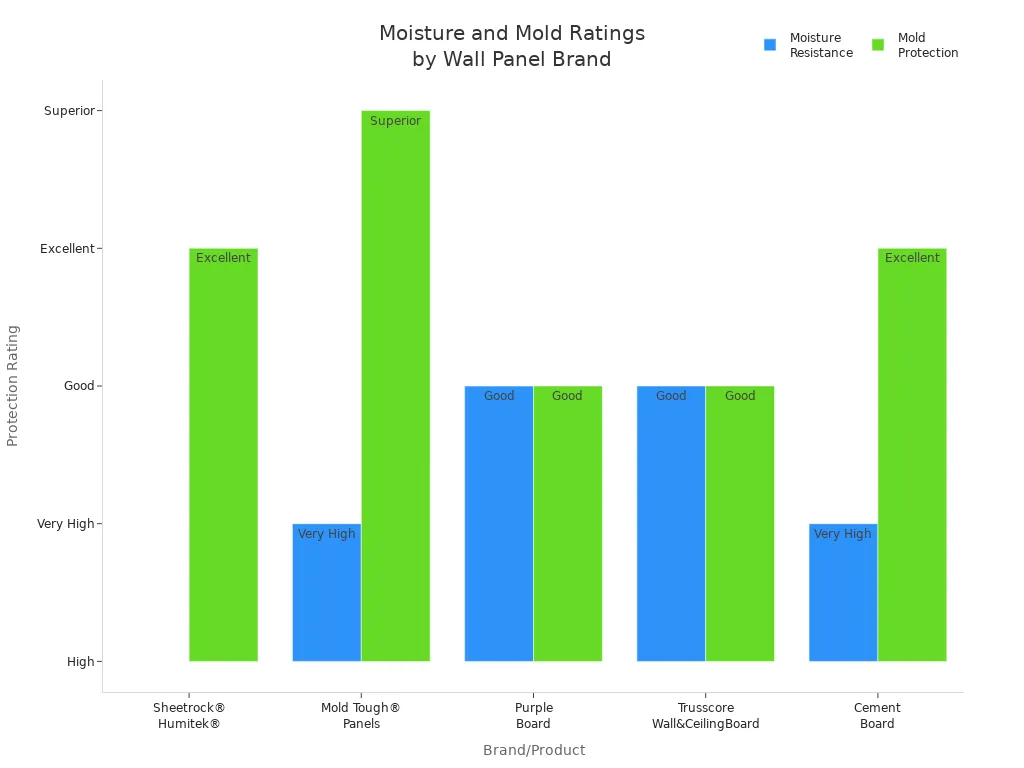
Brand/Product | Moisture Resistance | Mold Protection | Notes |
|---|---|---|---|
Sheetrock® Brand Humitek® | High | Excellent | Changed moisture resistance standards in 2003 |
Mold Tough® Panels | Very High | Superior | Enhanced mold prevention features |
Purple Board | Good | Good | Suitable for wet spaces |
Trusscore Wall&CeilingBoard | Good | Good | Effective in humid areas |
Cement Board | Very High | Excellent | Ideal for tiled areas, heavy and hard to install |
Tip: Pick waterproof wall paneling that is also fireproof. This gives you extra safety in your shower or bathroom.
Durability
You need panels that last a long time. Waterproof wall paneling does not dent or scratch easily. It also stands up to water damage. Mold resistant wall panel choices use strong materials and special coatings. These features help the panels last longer than regular ones. Fireproof panels, like MgO and SPC, give even more protection. You can feel sure your shower walls will stay strong.
Feature | Standard Panels | |
|---|---|---|
Moisture Resistance | Designed to deflect moisture effectively | Prone to water damage |
Mold Resistance | Lowers likelihood of microbial growth | Higher risk of mold |
Material Composition | Composite materials with advanced coatings | Basic materials |
Durability | Exceeds industry standards | Often less durable |
Customization Options | Wide variety of customizable features | Limited options |
Sustainability | Eco-friendly manufacturing processes | Not prioritized |
Easy Cleaning
You save time when you use waterproof wall paneling. Mold resistant wall panel surfaces, like PVC, only need mild soap and a soft cloth. You do not need strong cleaners or lots of scrubbing. Regular wall surfaces soak up stains and take more work to clean. You can clean your shower walls fast and keep mildew away.
Mold resistant wall panels need only light cleaning sometimes.
Regular walls need deep cleaning more often.
You avoid tough stains and mold with waterproof wall paneling.
Feature | Traditional Wall Surfaces | |
|---|---|---|
Maintenance | Low maintenance, easy to clean | Requires intensive cleaning |
Stain Resistance | Highly stain-resistant | Absorbs stains easily |
Mold and Mildew Resistance | Waterproof, resists moisture | Susceptible to mold and mildew |
Cleaning Method | Mild soapy water, non-abrasive | Harsh chemicals often needed |
Frequency of Cleaning | Occasional light cleaning | Regular deep cleaning required |
Note: You keep your shower and bathroom looking nice with easy cleaning.
Types of Shower Wall Panels
 MgO Panels
MgO Panels
MgO panels are good for showers. They stop mold and fire. Magnesium oxide makes them strong and safe. These panels block water well. Mold cannot grow on them. MgO panels are heavier than some others. Each sheet costs $18 to $25. Many people can afford them.
SPC Panels
SPC panels have a stone-plastic core. They keep all water out. Mold and mildew do not grow on them. SPC panels also kill germs. Your shower stays clean. You can put SPC panels up easily. They last a long time. Many people like how modern they look.
WPC Panels
WPC panels mix wood and plastic. They are tough and block water. These panels work in showers and wet rooms. WPC panels stop mold. They are not as waterproof as SPC or PVC. You can pick from many colors and styles. You can match your shower design.
FRP Panels
FRP panels use fiberglass. They soak up very little water. Mold does not grow on them. You must install FRP panels carefully. You need dry-fitting and special glue. Each sheet costs about $116 with backer boards and glue. FRP panels last a long time. You only need to clean them sometimes.
PVC Panels
PVC panels are a top choice for showers. They keep water out and stop mold. A 4’x8’ sheet costs about $83.58. You save up to half the labor cost compared to FRP. PVC panels are easy to put up and clean. They are not as strong as fiberglass or stone.
Tip: PVC panels are best for showers and bathrooms. They give strong waterproofing and are easy to clean.
Moisture-Resistant Gypsum
Moisture-resistant gypsum panels protect against mold. They cost $10 to $15 per sheet. You can use them in wet rooms. They do not last as long as SPC or FRP panels. Moisture-resistant gypsum works well under tiles or as a base.
Pros and Cons
Panel Type | Pros | Cons |
|---|---|---|
MgO | Fireproof, mold resistant, affordable | Heavy, may need special tools |
SPC | 100% waterproof, antibacterial, easy to install | Fewer design options, higher cost |
WPC | Durable, many styles, resists mold | Less waterproof than SPC/PVC |
FRP | Very durable, low water absorption | Expensive, complex installation |
PVC | Affordable, easy to install, waterproof | Less durable, limited designs |
Moisture-Resistant Gypsum | Low cost, good mold resistance | Not as durable, needs protection from water |
Note: Pick shower wall panels that fit your budget and style. Think about how much water your shower gets. Each type gives different waterproofing and mold resistance.
Choosing the Right Panel for Your Shower
 Assessing Needs
Assessing Needs
Think about how you use your shower. Decide what you want from your wall panels. If your home is busy, pick panels that are easy to clean. Mold resistant panels are good for homes and businesses. Non-porous surfaces keep water out. They help stop mold and mildew. You want panels that last a long time. They should not scratch or stain easily. Solid surface panels work well in commercial places. They stop mold and need less cleaning. At home, you may care more about style and price.
Tip: Seamless panels are easy to install. They save you time and money.
Cost and Performance
You want good value for your shower wall panels. High-performance panels cost more at first. They last longer and need less work. Check the table below to compare costs and lifespan:
Material | Installation Cost (per sq. ft.) | Maintenance Cost (per year) | Lifespan |
|---|---|---|---|
FRP Panels | $4 – $7 | Very Low | 25–30 years |
Drywall | $2 – $4 | Medium | 10–15 years |
Ceramic Tile | $10 – $20 | Low | 30+ years |
Painted Concrete/Plaster | $5 – $8 | Medium-High | 20–25 years |
Pick panels that last longer and need less cleaning. FRP panels are a smart choice for showers. They resist mold and need little upkeep.
Design and Style
There are many styles for shower wall panels. Some look like stone or wood. Others have bright colors or smooth finishes. The table below shows which panels work best in different places:
Panel Type | Key Features | Applications |
|---|---|---|
PVC | Waterproof, mold-resistant, easy to clean | Bathrooms, shower cabins, laundry rooms |
WPC | Water and insect resistant, wood-like appearance | Kitchens, balconies, semi-outdoor spaces |
SPC | Fire-retardant, stone or tile appearance | Luxury bathrooms, spa facilities, hotels |
Pick panels that match your style and space. Make your shower look the way you want.
Safety and Environment
You want your shower to be safe and healthy. Look for panels with safety labels and low chemical emissions. Some panels meet standards for mold resistance and air quality. Fire safety is important too. Panels with fire ratings help protect your shower.
Certification/Standard | Description |
|---|---|
ASTM D3273 | Tests mold resistance in humid conditions |
GREENGUARD Certification | Ensures low chemical emissions |
ASTM E84 | Measures flame spread and smoke ratings |
EN 13501 | European fire classification |
PAS 670:2021 | Performance requirements for building materials |
Note: Always check for safety and environmental labels before you buy panels for your shower.
Installation Guide
Tools and Prep
You need the right tools to install waterproof wall paneling in wet areas. Gather these items before you start:
Fine tooth hand saw – Cut panels to the correct size.
Measuring tape – Measure twice for accuracy.
Pencil – Mark where you need to cut.
Safety glasses – Protect your eyes while cutting.
Silicone gun – Apply sealant after you finish.
Stanley knife – Trim excess or cut sections.
Spirit level – Make sure panels are straight.
Safety gloves – Keep your hands safe.
Pre-Installation Preparation is one of the most important steps in installing waterproof shower wall panels. Before you begin the installation, it is essential to measure the area accurately, prepare the wall and dry-fit the panels.
You should clean the wall surface. Make sure it is flat and even. Dry-fit the panels to check the fit before you use adhesive. This step helps you avoid problems later.
Step-by-Step Process
Follow these steps for the best results when you install waterproof wall paneling:
Measure the wall area and mark where each panel will go.
Cut panels to size using the hand saw or Stanley knife.
Dry-fit each panel to check alignment and fit.
Apply adhesive to the back of the panel.
Press the panel onto the wall. Use a spirit level to keep it straight.
Roll or press the panel to remove air pockets.
Seal edges with silicone using the gun.
Wipe away excess sealant and check for gaps.
You will notice the ease of installation when you use the right tools and follow these steps. This installation guide helps you get a clean, professional look.
Mistakes to Avoid
Many people make mistakes when they install waterproof wall paneling. You can avoid these problems by following this table:
Mistake | Problem | How to Avoid |
|---|---|---|
Adhesive won’t stick, panels bubble or peel | Clean and dry the wall, make sure it is even | |
Using the Wrong Adhesive | Weak bonds, panel failure | Use FRP-specific adhesives, follow instructions |
Neglecting Expansion Gaps | Panels buckle or crack | Leave gaps for expansion, use oversized holes |
Improper Fastening Techniques | Cracks, poor structure | Pre-drill holes, use corrosion-resistant fasteners |
Failing to Roll or Press Panels | Adhesion failure, warping | Use a roller, press panels for full contact |
You can avoid costly repairs if you follow this installation guide. Always check your work and use the right materials.
Maintenance for Mold Resistant Wall Panels
Cleaning Tips
You can keep your mold resistant wall panels looking new with regular cleaning. Dirt, grime, and soap scum can build up over time, especially in bathrooms and kitchens. Cleaning helps stop mold before it starts. Use a soft, non-abrasive cloth and soapy water to wipe down the panels. Focus on any stained spots. If you see moldy caulk, it is best to remove and replace it. Mold in caulk is hard to clean once it sets in.
Here are some simple steps for cleaning:
Clean your wall panels often to stop mold and mildew from growing.
Soak stained areas with soapy water for two to five minutes before wiping.
Always remove any mold before painting. Mold can bleed through paint if left behind.
Tip: Regular cleaning not only keeps your panels fresh but also makes your bathroom and kitchen healthier.
Inspections
You should check your wall panels at least once a year. Inspections help you find small problems before they get worse. Look for cracks, loose edges, or signs of water getting behind the panels. If you live in a place with harsh weather, check your panels more often. Regular inspections keep your panels working well and help you spot mold early.
Annual inspections are best for most homes.
Check more often if your area has lots of rain or humidity.
Look closely at corners and seams where water can sneak in.
When to Replace
Sometimes, cleaning and repairs are not enough. You may need to replace your wall panels if you see these signs:
Panels have deep cracks or holes.
Mold keeps coming back even after cleaning.
Water damage has caused panels to warp or peel.
The surface feels soft or spongy.
Replacing old panels keeps your home safe and clean. New panels also improve the ease of maintenance, making future cleaning and care much simpler.
Benefits and Applications
 Home Uses
Home Uses
Mold resistant wall panels help wet areas in your home. You can use them in bathrooms, laundry rooms, and kitchens. These panels protect your walls from water and mold. They make a barrier that keeps water out. This stops mold from growing and keeps the air fresh. You will find it easier to clean your walls. Grime and bacteria do not stick as much.
Stops mold by blocking water.
Makes air cleaner and lowers health risks.
Helps you keep walls clean and easy to care for.
You have lots of choices for shower walls. Glass tile surrounds look modern and block water. Laminate shower panels are easy to clean and come in many styles. PVC composite surrounds stay strong and do not crack or bend. These waterproof panels help you avoid expensive repairs. The table below shows the benefits:
Material Type | Benefits | Longevity Impact |
|---|---|---|
Blocks mold, keeps water out, strong core | ||
PVC wall panels | Blocks water, keeps color, protects from sun | Keeps design and shape |
PVC panels do not bend or stain. Your shower stays looking new. Fire-resistant panels make your home safer. You can pick glass tile surrounds for style. Laminate panels are easy to clean. PVC composite surrounds protect your shower for a long time.
Commercial Uses
Many businesses use mold resistant wall panels. Hospitals and clinics use PVC panels to keep rooms clean. These panels help stop germs from spreading. Hotels use glass tile surrounds and laminate panels in lobbies and bathrooms. These panels look nice and last a long time. Gyms put mold resistant panels in locker rooms and showers. This keeps mold away and the area fresh.
Hospitals use panels for clean rooms and quick changes.
Hotels pick strong panels for style and easy cleaning.
Gyms use panels to stop mold in wet places.
PVC composite surrounds help save money on repairs. These panels do not get ruined by water. They are easy to put up and need little care. Laminate panels and glass tile surrounds also help save money over time.
Tip: You can use waterproof panels like PVC composite surrounds in homes and businesses. They help keep places safe and clean.
Picking mold resistant wall panels helps protect wet rooms. These panels last longer and help keep your home healthy.
Feature | Description |
|---|---|
Material Composition | Mold-resistant panels use fiberglass or PVC, so they do not soak up water. |
Durability | These panels last longer than drywall or tile in damp places. |
Resistance Ratings | High ratings mean better mold protection and less fixing. |
Waterproof panels are simple to put up and easy to care for.
You stop mold and have a cleaner, safer room.
New wall panels give you peace of mind and add value.
Take action now to keep your home safe and enjoy a fresh, worry-free space.
FAQ
What is the easiest mold resistant wall panel to install?
PVC panels are the easiest for you to install. You can cut them with basic tools. You do not need special adhesives. The panels snap together quickly. You save time and effort.
How often should you clean mold resistant wall panels?
You should clean your panels once a week. Use a soft cloth and mild soap. Regular cleaning helps you stop mold and keep your walls looking fresh.
Can you paint over mold resistant wall panels?
You can paint some panels, like moisture-resistant gypsum. You should check the manufacturer’s instructions first. Many PVC and FRP panels do not need paint and look good as they are.
Are mold resistant wall panels safe for kids and pets?
Most panels, like PVC and SPC, are safe for kids and pets. Look for panels with low chemical emissions. Check for safety certifications such as GREENGUARD.
Which panel lasts the longest in wet areas?
SPC and FRP panels last the longest. You get up to 30 years of use. These panels resist water and mold. You spend less on repairs over time.

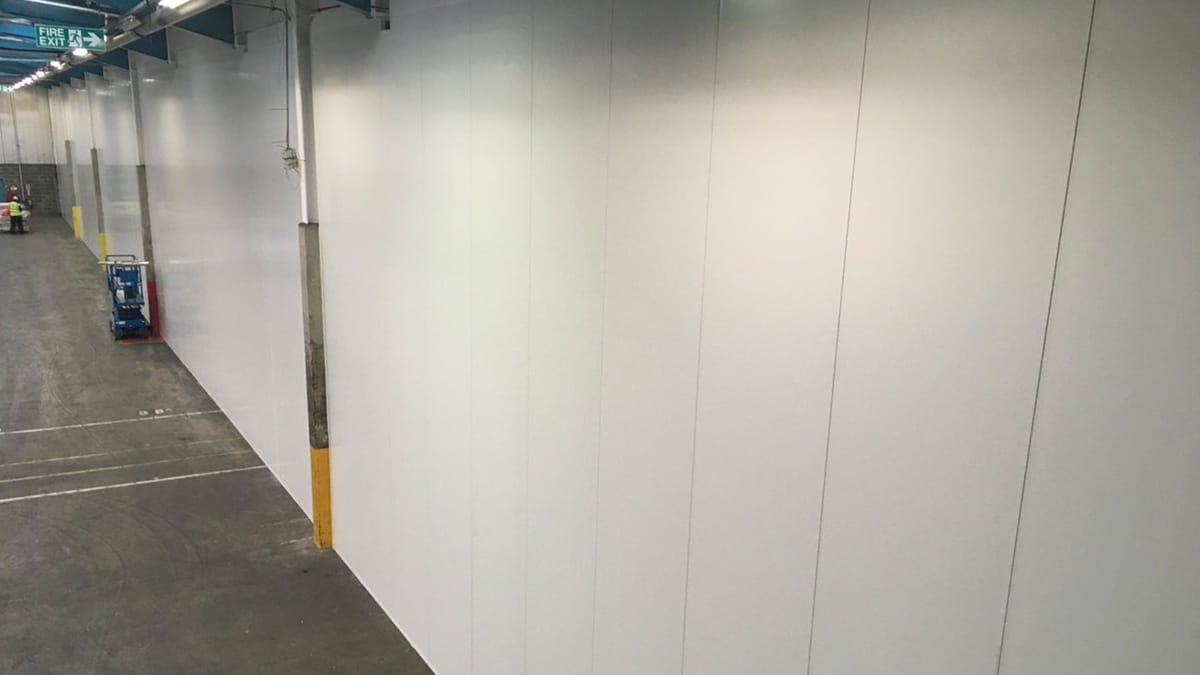 MgO Panels
MgO Panels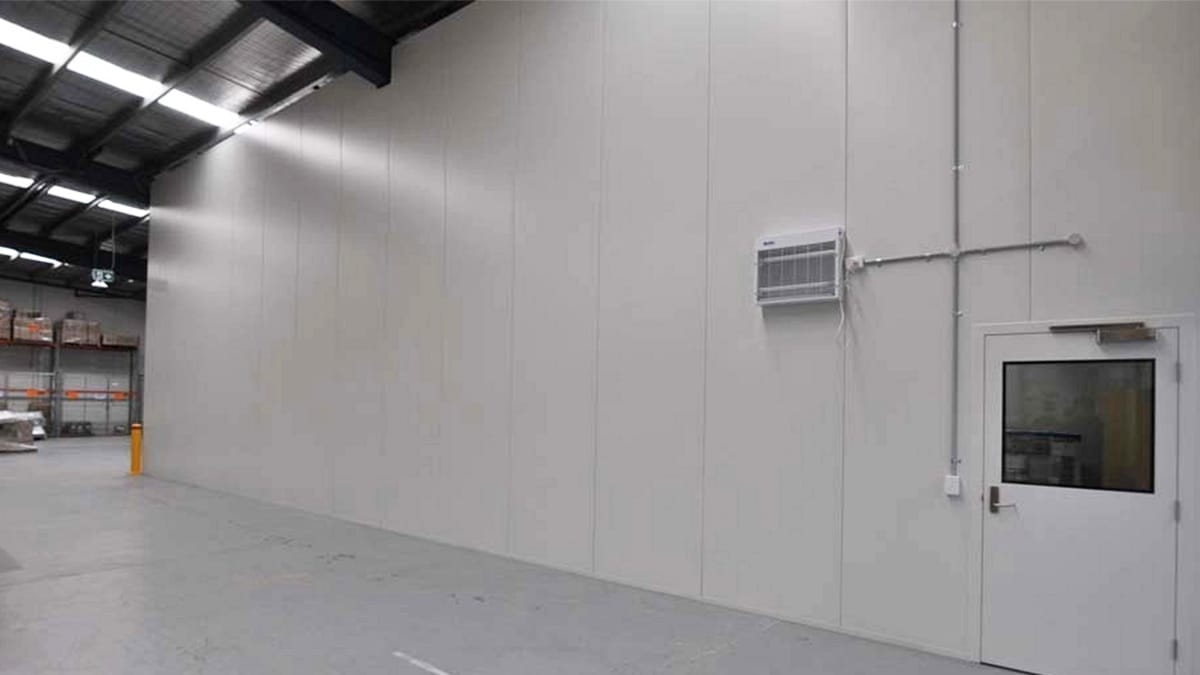 Home Uses
Home Uses